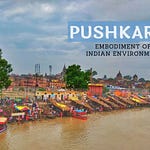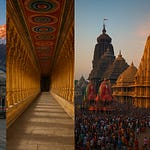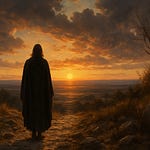Hidden amidst the misty hills and lush green forests of the Eastern Ghats, near the border of Telangana and Andhra Pradesh, lies one of India's most intriguing ancient temples — the Rampa Rudreshwara Temple, also popularly known as the Sri Rampa Lakshmana Swamy Temple.
This sacred site isn't just revered for its spiritual energy — it's architecturally and historically significant, believed to have been constructed by the mighty Kakatiya dynasty using a unique ancient technique involving sand-based lightweight bricks that float on water, known locally as Rechkaure.
🧱 The Mystery of the Floating Bricks (Rechkaure)
Among the many legends associated with the temple, the most astonishing is the use of bricks that float on water. These special bricks, called Rechkaure in the local tribal dialect, are believed to be made of a mixture of sand, medicinal herbs, and lightweight materials — a construction marvel pioneered by the Kakatiyas.
Legend vs. Science:
Devotees' Belief: The floating bricks are divine and date back to Treta Yuga, possibly part of Lord Rama’s bridge or temple structures.
Historical Interpretation: These bricks may have been created using ancient aerated brick techniques, involving volcanic ash, lime, and rice husk ash — resulting in low-density, porous structures capable of floating.
This technique reflects the advanced knowledge of materials science, architecture, and environmental harmony possessed by the Kakatiya architects.
🏰 The Kakatiya Empire’s Contribution
The Kakatiya Dynasty (12th–14th century CE), known for their architectural grandeur and engineering excellence, is credited with constructing the Rampa Rudreshwara Temple.
The Kakatiyas were great patrons of Shaivism, and many temples across present-day Telangana and Andhra Pradesh were built by them.
Sand and rock construction, intricate stone carvings, and floating brickwork were hallmarks of their temple architecture — seen in other marvels like Ramappa Temple (UNESCO World Heritage Site).
The Rampa Temple, though lesser known, is believed to have been built by Kakatiya rulers as part of their eastern frontier sacred infrastructure.
📜 Mythological and Historical Significance
Associated with the Ramayana, it's believed that Lord Rama, Sita, and Lakshmana spent part of their vanvas (exile) in this forest region.
Lord Lakshmana is said to have meditated here and established a shrine for Lord Shiva, hence the name Rudreshwara.
The temple also enshrines Sri Rama, Sita Devi, and Hanuman, representing the unity of Vaishnavism and Shaivism — a powerful symbol of spiritual integration.
🕉️ Deities Worshipped
Lord Rudreshwara (Shiva)
Sri Lakshmana Swamy – Rarely worshipped independently in temples
Sri Rama, Sita Mata, Lord Hanuman
🎉 Major Festivals Celebrated
Rudreshwara Jatara – A major tribal-spiritual congregation
Maha Shivratri – Night-long rituals and abhishekams
Sri Rama Navami – Celebrates the birth of Lord Rama
Tribal Harvest Festivals – Celebrated with dance, music, and offerings
🌿 Natural Beauty and Tribal Culture
The temple is located in a scenic forested zone near Rampachodavaram, embraced by:
Maredumilli Reserve Forest
Jalatarangini & Amruthadhara Waterfalls
Sacred groves & tribal communities
The surrounding area offers not only spiritual peace but also cultural richness, wildlife, and eco-tourism experiences.
🧭 Travel Information
Location: Rampachodavaram, Alluri Sitharama Raju District, Andhra Pradesh (near Telangana border)
🚗 By Road:
Bhadrachalam (Telangana): ~120 km
Rajahmundry (AP): ~70 km
Hyderabad: ~380 km
🚆 Nearest Railway Station:
Rajahmundry
✈️ Nearest Airport:
Rajahmundry Airport
🏨 Stay Options
Local lodges and guest houses in Rampachodavaram
Eco-resorts in Maredumilli
Full-service hotels in Rajahmundry
✨ Why You Should Visit
Witness ancient Kakatiya architecture with floating brick construction
Soak in the mystical energy of a Ramayana site
Discover an untouched natural paradise in tribal lands
Attend vibrant festivals that blend spirituality with local culture
📌
The Rampa Rudreshwara Temple is not just a place of worship — it's a living mystery, an architectural wonder, and a spiritual sanctuary. Built by the great Kakatiya dynasty, using a technique that still puzzles modern engineers, the floating bricks of Rampa remain a testimony to India’s rich, yet underexplored, civilizational genius.
Whether you are a devotee, a history lover, a seeker of truth, or an admirer of the unexplained — Rampa offers an experience like no other.










